Picking the best breeds for family dogs can be tough. Did you know that some breeds are better with kids than others? This guide will help you find the perfect furry friend for your home.
Get ready to meet five amazing dog breeds that’ll make your family complete!
Key Takeaways
The top 5 family dog breeds are Cavalier King Charles Spaniel, Labrador Retriever, Golden Retriever, Poodle, and Border Collie.
Key traits for family dogs include friendly temperament, right size and energy level for your home, and potential hypoallergenic qualities.
Cavalier King Charles Spaniels are gentle lapdogs weighing 13–18 pounds, while Labs and Goldens are larger, active breeds needing lots of exercise.
Poodles come in three sizes and shed little, making them good for allergy sufferers, but need regular grooming.
All family dogs need proper care including vet check-ups, good food, daily exercise, training, and lots of love and attention.
Table of Contents
Characteristics of Ideal Family Dog Breeds

Finding the right family dog is key. Good family dogs have certain traits that make them great with kids and adults alike.
Assessing Temperament for Compatibility
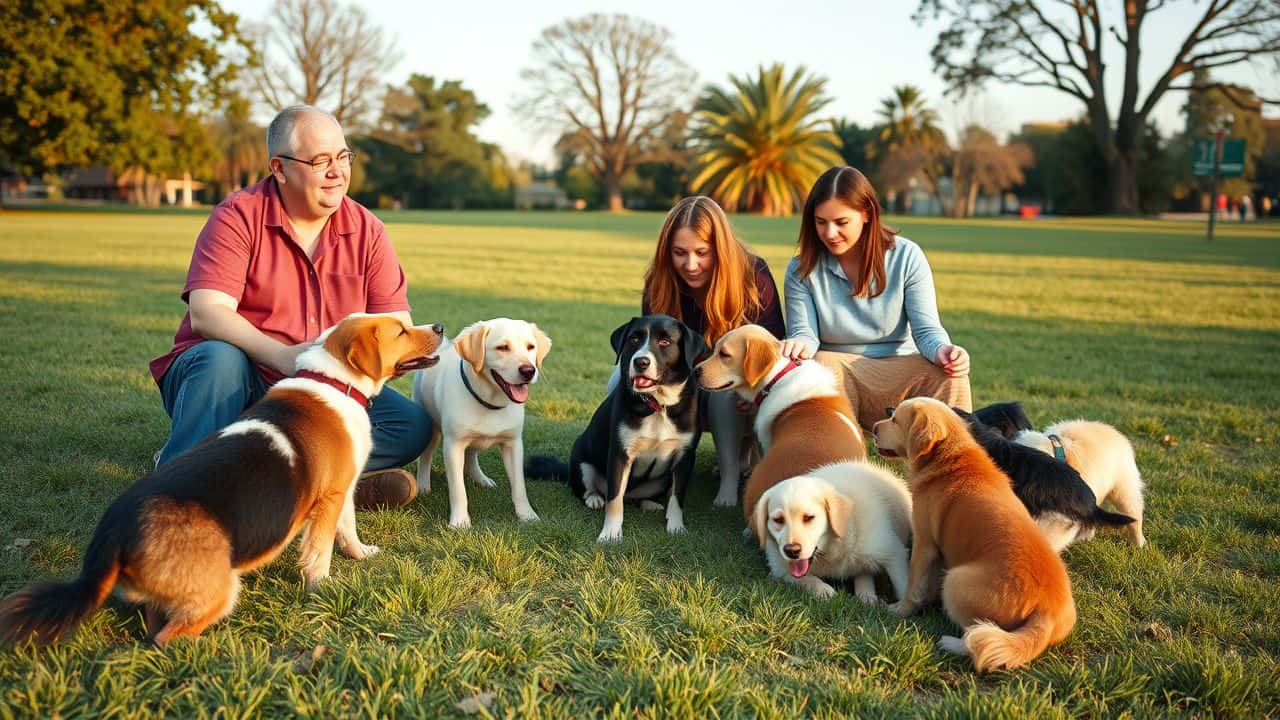
Picking a dog with the right temperament is key for a happy home. A dog’s personality should fit well with your family’s lifestyle and needs. To gauge this, spend time with different dogs in various settings.
Watch how they act around kids, other pets, and strangers. This will give you a good idea of their true nature.
Look for traits like friendliness, patience, and playfulness. These qualities often make great family pets. But don’t forget to consider your own energy level too. A calm family might not mesh well with a high-energy pup.
A dog’s temperament is the foundation of a lasting bond with your family.
If you’re unsure, ask a pro at a shelter or where to buy a dog online. They can help match you with the perfect pooch for your clan.
Evaluating Size and Energy Levels
After looking at a dog’s personality, we need to think about its size and energy. These factors play a big role in finding the right fit for your family.
Size matters when picking a furry friend. A Labrador Retriever, weighing 55–80 pounds, might be too big for a small apartment. On the flip side, a Brussels Griffon at 8–10 pounds could get lost in a large house.
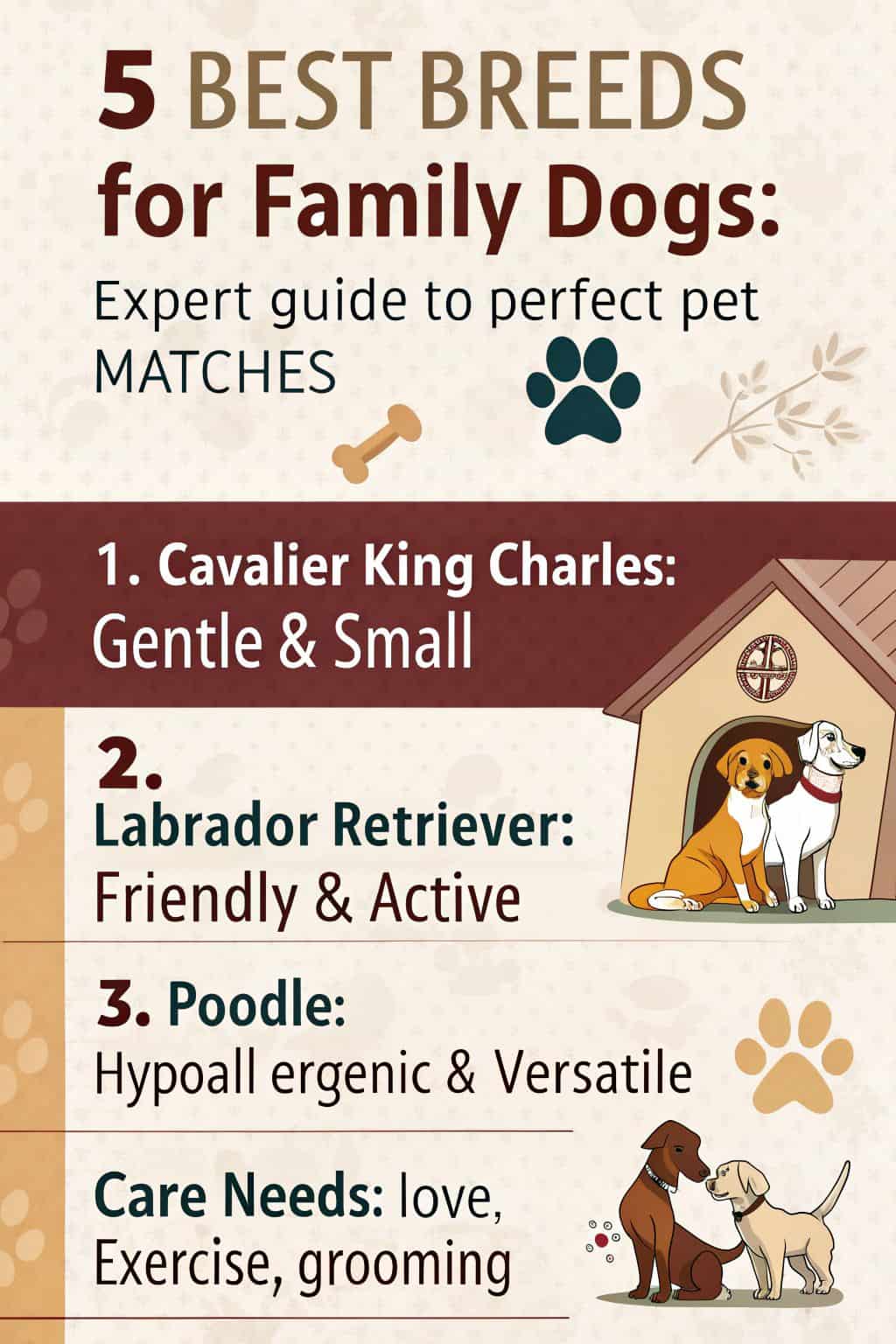
Energy levels are just as crucial. Beagles are full of zip and zest, perfect for active families. But if you prefer quiet nights in, a French Bulldog’s laid-back nature might suit you better.
From my experience, matching a dog’s size and energy to your lifestyle leads to a happier home for everyone.
Considering Hypoallergenic Traits
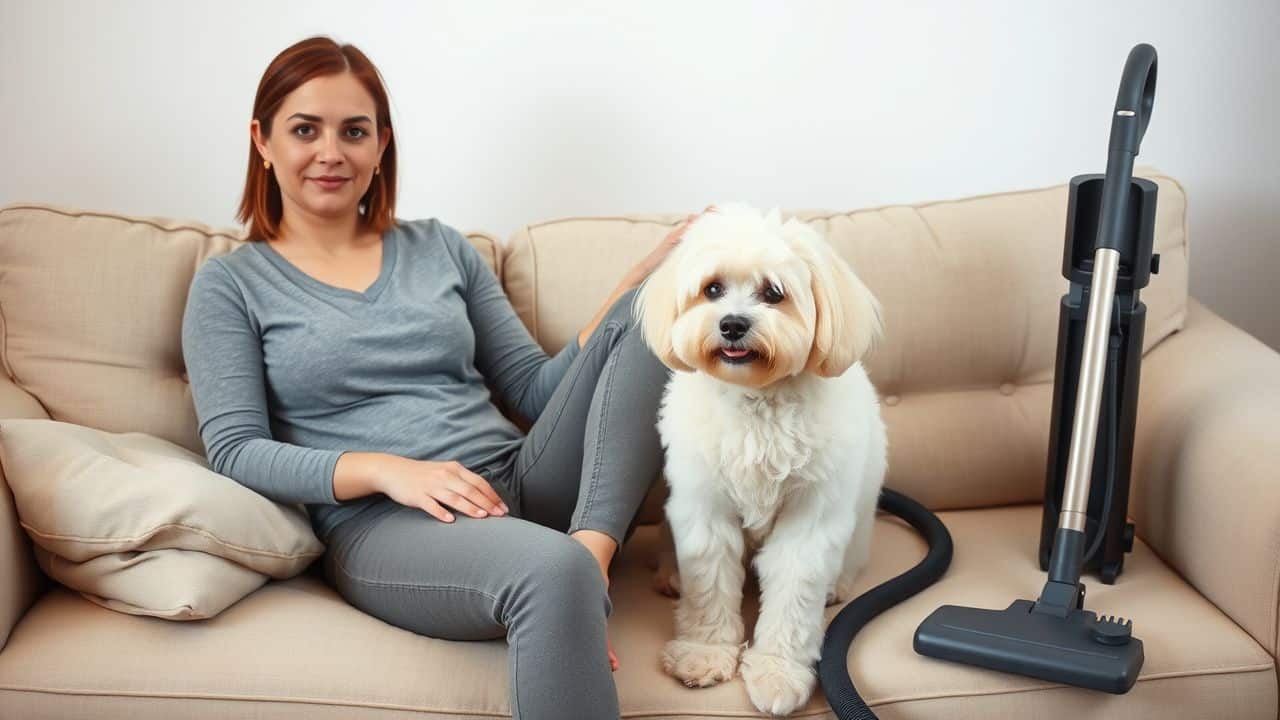
Hypoallergenic dogs are a game-changer for allergy sufferers who love pups. These special breeds shed less and make fewer allergens. Poodles, Bichon Frise, and Maltese top the list of sneeze-free companions.
But here’s the scoop: no dog is 100% allergy-proof. Even so, these furry friends can make life easier for those who usually can’t be around dogs.
Keeping your home clean is key when you have a hypoallergenic dog. Regular baths and brushing help cut down on loose fur and dander. I’ve found that using a good vacuum and air purifier works wonders too.
With the right care, you can cuddle up with your pup without fear of sneezing fits or itchy eyes. It’s like having your cake and eating it too – all the joy of a dog without the allergy woes!
Top Small Breed for Families: Cavalier King Charles Spaniel

Meet the Cavalier King Charles Spaniel, a small dog with a big heart. These pups are perfect for families who want a gentle, loving companion that’s easy to care for.
Overview of Cavalier King Charles Spaniel
 Cavalier King Charles Spaniels are small, lovable dogs that fit perfectly into family life. These pups weigh between 13–18 pounds and stand about a foot tall at the shoulder. Their silky coats come in four color combos and need regular brushing to stay shiny.
Cavalier King Charles Spaniels are small, lovable dogs that fit perfectly into family life. These pups weigh between 13–18 pounds and stand about a foot tall at the shoulder. Their silky coats come in four color combos and need regular brushing to stay shiny.
These little charmers have big, round eyes that melt hearts and floppy ears that frame their sweet faces.
These dogs have calm, gentle souls that make them great with kids and other pets. They love to cuddle but also enjoy short walks to stay healthy. Training is a breeze since they aim to please and work hard for treats.
While they’re mostly healthy, they can face some joint issues as they age. Many folks say dogs are better than people, and Cavaliers prove this with their loving nature.
From my time with these pups, I can say they’re true lapdogs who thrive on human contact.
Advantages and Disadvantages of Cavalier King Charles Spaniel

Now that we’ve covered the basics, let’s weigh the pros and cons of this lovable breed. Cavalier King Charles Spaniels have unique traits that make them great family pets, but they also come with some challenges.
Advantages:
- Affectionate nature: These dogs love to cuddle and bond with family members.
- Easy grooming: Their coat needs little upkeep and sheds minimally.
- Smart and trainable: They learn quickly and aim to please their owners.
- Low exercise needs: A short daily walk of 20–30 minutes is enough.
- Good with kids: Their gentle nature makes them great playmates for children.
Disadvantages:
- Weather sensitivity: They don’t do well in extreme heat or cold.
- Separation anxiety: These dogs get upset when left alone for long periods.
- Health issues: They may face breed-specific health problems.
- Barking: Some Cavaliers can be vocal, which might bother neighbors.
- Cost: Purebred Cavaliers can be pricey to buy and care for.
Preferred Medium Breed for Families: Labrador Retriever
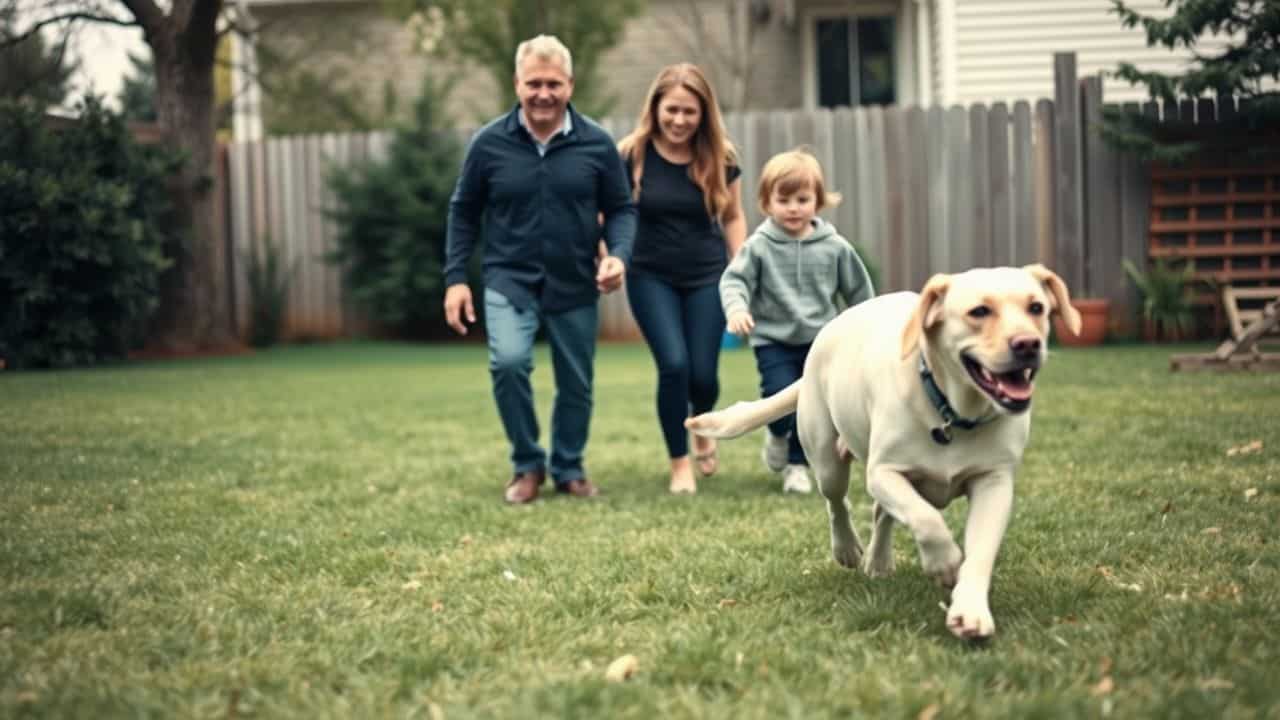 Labrador Retrievers are a top pick for families. They’re friendly, smart, and great with kids of all ages.
Labrador Retrievers are a top pick for families. They’re friendly, smart, and great with kids of all ages.
Overview of Labrador Retriever
Labrador Retrievers are a top pick for families. These friendly pups love to play and cuddle. They’re smart and easy to train, which makes life easier for busy moms and dads. Labs come in three colors: yellow, black, and chocolate.
Their short coat is a breeze to care for, perfect for families on the go.
These dogs are part of the Sporting group, so they’re full of energy. They need lots of exercise to stay happy and healthy. A tired Lab is a good Lab! They’re also great with kids.
Their patient nature means they can handle little ones tugging on their ears or tail. It’s important to note that early training and socializing are key to raising a well-behaved furry family member.
Advantages and Disadvantages of Labrador Retriever
Labrador Retrievers are popular family dogs for good reasons. Let’s look at their pros and cons:
Advantages:
- Friendly nature: Labs love people and get along well with kids and other pets.
- Smart and trainable: These dogs learn quickly, making them easy to teach new tricks.
- Active and playful: They’re great for families who enjoy outdoor activities.
- Low grooming needs: A quick brush and occasional bath keep them looking good.
- Versatile workers: Labs excel in many roles, from guide dogs to search and rescue.
Disadvantages:
- High energy: They need lots of exercise to stay happy and healthy.
- Shedding: Labs lose a fair amount of fur, especially during seasonal changes.
- Health issues: They can face problems like hip dysplasia and eye conditions.
- Big appetites: These dogs love to eat and can gain weight if not watched closely.
- Need for attention: Labs don’t do well when left alone for long periods.
Leading Large Breed for Families: Golden Retriever
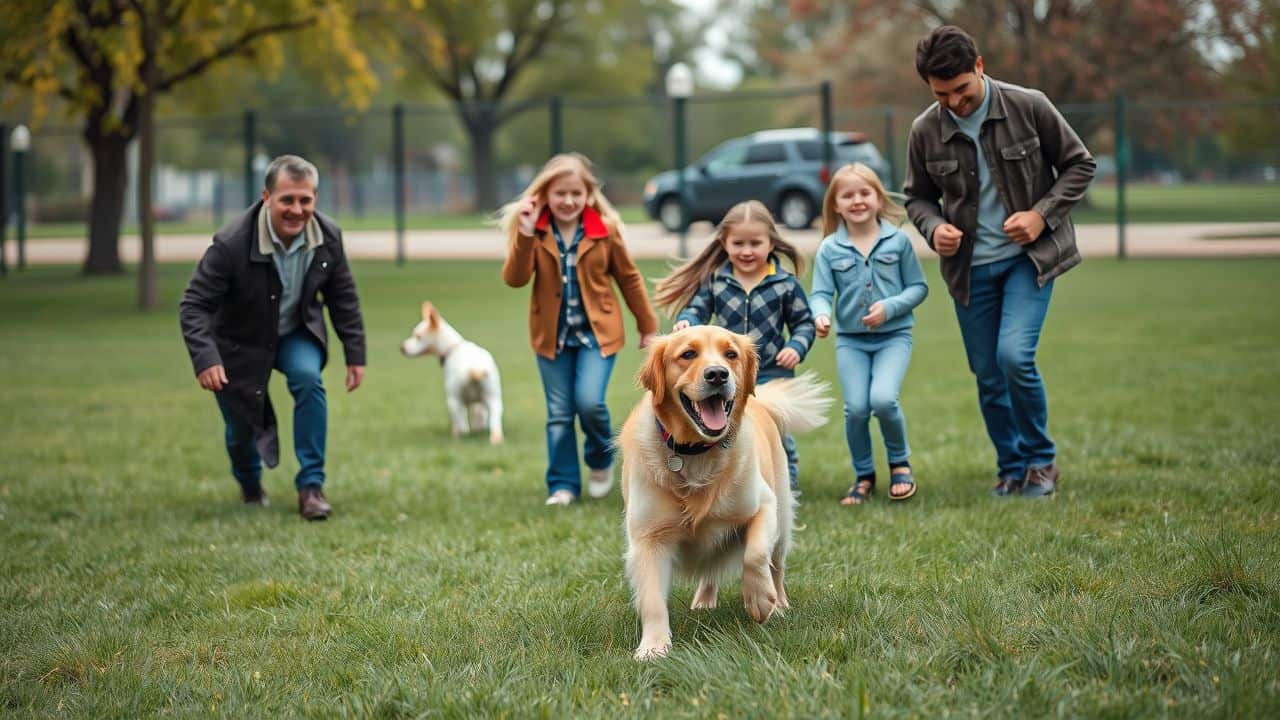 Golden Retrievers are a top pick for families with kids. Their gentle nature and love for play make them great companions for children of all ages.
Golden Retrievers are a top pick for families with kids. Their gentle nature and love for play make them great companions for children of all ages.
Overview of Golden Retriever
Golden Retrievers are a top pick for families. These smart, loyal dogs have a gentle nature that makes them great with kids and other pets. They sport a beautiful golden coat that needs regular brushing.
Their friendly faces and wagging tails can brighten any home.
A Golden Retriever is like sunshine wrapped in fur.
These pups need lots of exercise to stay happy and healthy. They love to play fetch and go for long walks. Golden Retrievers are easy to train and eager to please their owners. Their intelligence and kind hearts make them perfect for family life.
Advantages and Disadvantages of Golden Retriever
Now that we’ve covered the basics of Golden Retrievers, let’s explore their pros and cons. These lovable furballs have a lot to offer, but they’re not perfect for every family.
Advantages:
- Friendly nature: Golden Retrievers are known for their warm, welcoming personality. They get along well with kids, other pets, and even strangers.
- Smart and trainable: These dogs pick up commands quickly. Their smarts make them great for therapy work and service roles.
- Active lifestyle companions: Goldens love to play and exercise. They’re perfect for families who enjoy outdoor activities.
- Gentle with children: Their patient and kind demeanor makes them ideal playmates for kids of all ages.
- Loyal family members: These dogs form strong bonds with their owners. They’ll stick by your side through thick and thin.
Disadvantages:
- High shedding: Golden Retrievers shed a lot. You’ll need to brush them often and vacuum regularly to keep your home fur-free.
- Need for exercise: They require 40–60 minutes of daily activity. This might be too much for some busy families.
- Health issues: Goldens are prone to certain health problems. Regular vet check-ups are a must to catch issues early.
- Not great guard dogs: Their friendly nature means they’re more likely to welcome intruders than scare them off.
- Size concerns: These are medium to large dogs. They might not be the best fit for small apartments or homes with limited space.
- Attention seekers: Golden Retrievers crave human interaction. They can become destructive if left alone for long periods.
Optimal Hypoallergenic Breed for Families: Poodle
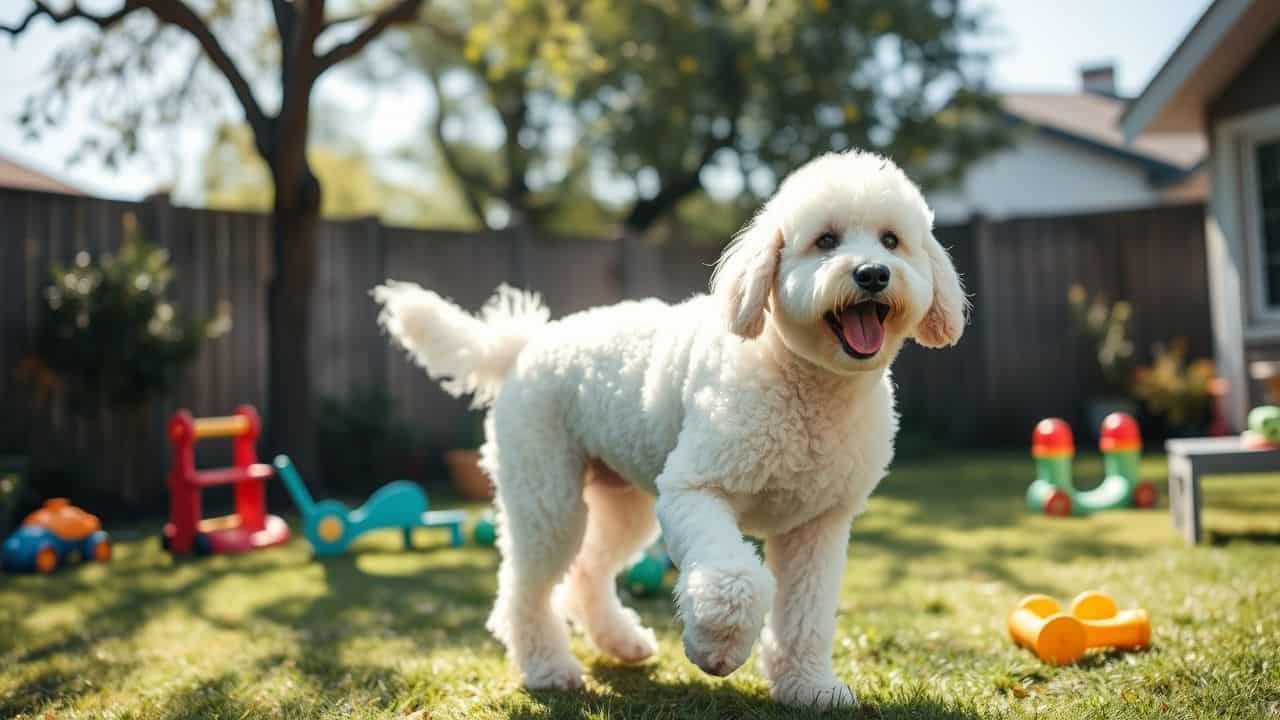
Poodles are smart, playful, and great with kids. Their curly coats shed less, making them a top pick for families with allergies.
Overview of Poodle
Poodles are smart, friendly dogs that come in three sizes: Standard, Miniature, and Toy. These curly-coated pups make great family pets. They’re known for being good with kids and other animals if you start socializing them early.
Poodles need about an hour of exercise each day to stay happy and healthy. Their coats are special because they don’t shed much and are good for people with allergies.
Taking care of a Poodle’s coat is a big job. You’ll need to brush them often to stop their fur from getting tangled. It’s best to take them to a groomer every six weeks for a trim.
I’ve had a Poodle for years, and I can tell you they’re worth the extra work. They’re loving, fun, and always ready to play or cuddle.
Poodles aren’t just pretty faces – they’re brainy, loyal, and full of love.
Advantages and Disadvantages of Poodle
Poodles are smart and low-shedding dogs that make great family pets. They have both pros and cons to consider before bringing one home.
Advantages:
- Smart cookies: Poodles are whip-smart, making training a breeze.
- Allergy-friendly: Their curly coats shed less, perfect for sneeze-prone folks.
- Adaptable: These pups fit well in apartments or houses.
- Playful pals: They love to romp and play with kids and adults alike.
- Variety pack: Come in three sizes – toy, mini, and standard.
Disadvantages:
- High-maintenance ‘dos: Their fancy coats need regular grooming.
- Costly cuts: Professional grooming can put a dent in your wallet.
- Health hiccups: Prone to issues like hip problems and eye troubles.
- Separation blues: Can get anxious when left alone too long.
- Exercise hounds: Need daily walks and playtime to stay happy.
Care tips:
- Brush their coat daily to avoid tangles.
- Give them plenty of mental stimulation with puzzles and games.
- Start training early to curb any bossy behavior.
- Socialize them with other dogs and people from a young age.
- Regular vet check-ups help catch health issues early.
Best Breed for Active Families: Border Collie
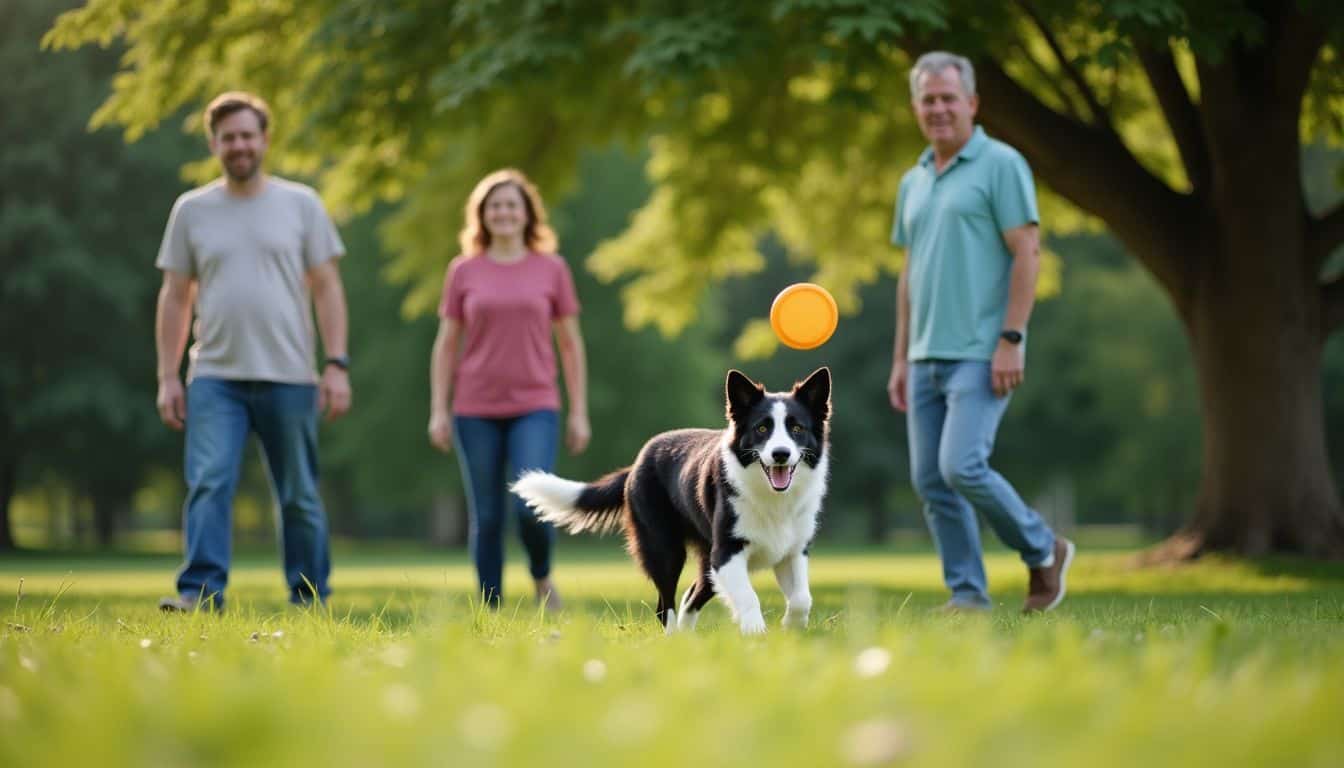 Border Collies thrive in active families. These smart pups need lots of exercise and mental challenges to stay happy.
Border Collies thrive in active families. These smart pups need lots of exercise and mental challenges to stay happy.
Overview of Border Collie
Border Collies are smart dogs with lots of energy. They come from the herding group and love to work hard. These pups need at least two hours of play every day to stay happy. They get along well with kids and other dogs, making them great family pets.
But they’re not couch potatoes – they need a job to do!
These dogs have some health issues to watch out for. Hip problems, eye diseases, seizures, and thyroid troubles can pop up. Taking care of a Border Collie costs about $1,000 to $2,000 each year.
They shed a lot, so regular brushing is a must to keep their coat nice. If you’re ready for an active, brainy buddy, a Border Collie might be your perfect match.
Advantages and Disadvantages of Border Collie
Border Collies are smart and loyal dogs that fit well with active families. They need lots of exercise and mental work to stay happy and healthy.
Advantages:
- Super smart: These pups learn tricks and commands fast, making training a breeze.
- Highly loyal: They form strong bonds with their families and love to please.
- Great for active folks: Border Collies thrive on long walks, runs, and playtime.
- Excellent watchdogs: Their alert nature helps keep your home safe.
- Long lifespan: With good care, they can live 12 to 15 years.
Disadvantages:
- High energy: They need tons of exercise, or they might get bored and destructive.
- Herding instinct: They may try to herd kids or other pets by nipping at their heels.
- Not great for small spaces: These dogs do best with a big yard to run in.
- Health issues: They can get hip problems and eye diseases as they age.
- Grooming needs: Their thick coats need regular brushing to stay tangle-free.
- Not for couch potatoes: If you’re not active, this breed might be too much to handle.
Essential Care Tips for Family Dogs

Caring for a family dog is a big job. Here are some key tips to keep your furry friend happy and healthy:
- Regular vet check-ups: Schedule yearly visits to catch health issues early.
- Proper nutrition: Feed high-quality dog food suited to your pet’s age and size.
- Daily exercise: Take walks or play fetch to keep your dog fit and content.
- Grooming routine: Brush fur, trim nails, and clean ears weekly.
- Dental care: Brush teeth daily or use dental chews to prevent gum disease.
- Training and socialization: Teach basic commands and expose your dog to new people and pets.
- Mental stimulation: Provide puzzle toys and games to keep your dog’s mind sharp.
- Safe environment: Dog-proof your home and yard to prevent accidents.
- Flea and tick prevention: Use vet-approved products to protect against parasites.
- Love and attention: Spend quality time with your dog every day to build a strong bond.
People Also Ask
What are the top 5 family-friendly dog breeds?
The cream of the crop for family pooches includes Labradors, Newfoundlands, Beagles, Irish Setters, and Pembroke Welsh Corgis. These breeds are known for their gentle nature and love for kids.
Are there good hypoallergenic options for families with allergies?
You bet! Standard Poodles, Bichon Frises, and Tibetan Terriers are great hypoallergenic breeds. They’re less likely to make you sneeze and wheeze while still being fantastic family pets.
How do rescue dogs compare to purebreds as family pets?
Rescue dogs can be diamonds in the rough! Mixed breeds often blend the best traits of different dogs. They’re just as loving and loyal as purebreds, and you’re giving a furry friend a second chance at happiness.
What should I consider when choosing a family dog?
Think about your lifestyle, living space, and energy levels. A Jack Russell Terrier might be too peppy for apartment living, while an English Bulldog could be perfect for couch potatoes. Don’t forget to factor in grooming needs and vet costs!
Are larger breeds like Saint Bernards good with kids?
Absolutely! Gentle giants like Saint Bernards, Leonbergers, and Old English Sheepdogs are often patient and protective with children. They’re like living teddy bears but remember – big dogs need big spaces!
How important is obedience training for family dogs?
It’s crucial! Whether you’ve got a smart cookie like a Vizsla or a stubborn pup like a Shih Tzu, training helps create a well-behaved canine companion. It’s the key to a harmonious household and a happy tail-wagger!
References
https://www.offleashk9training.com/choosing-the-perfect-family-companion-the-best-dog-breeds-for-your-home/ (2024-07-11)
https://dogacademy.org/breeds/cavalier-king-charles-spaniel (2024-08-29)
https://www.dogster.com/dog-breeds/cavalier-king-charles-spaniels-pros-cons (2024-07-31)
https://www.blisscavalierrescue.org/pros-and-cons-of-owning-a-cavalier-king-charles-spaniel/
https://www.akc.org/expert-advice/dog-breeds/best-family-dogs/
https://dogtime.com/dog-breeds/labrador-retriever
https://www.akc.org/dog-breeds/labrador-retriever/
https://www.dogster.com/dog-breeds/golden-retriever-pros-cons
https://www.petplan.co.uk/pet-information/dog/breed/poodle/
https://www.thesprucepets.com/poodle-dog-breed-profile-1117988
https://www.youtube.com/watch?v=1v23cGTu0p8
https://betterpet.com/border-collies/
https://blog.tryfi.com/are-border-collies-good-family-dogs/ (2023-10-22)
